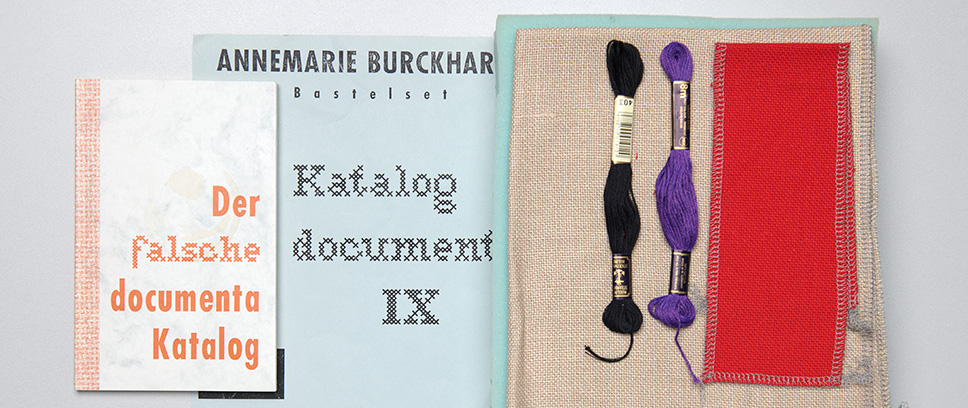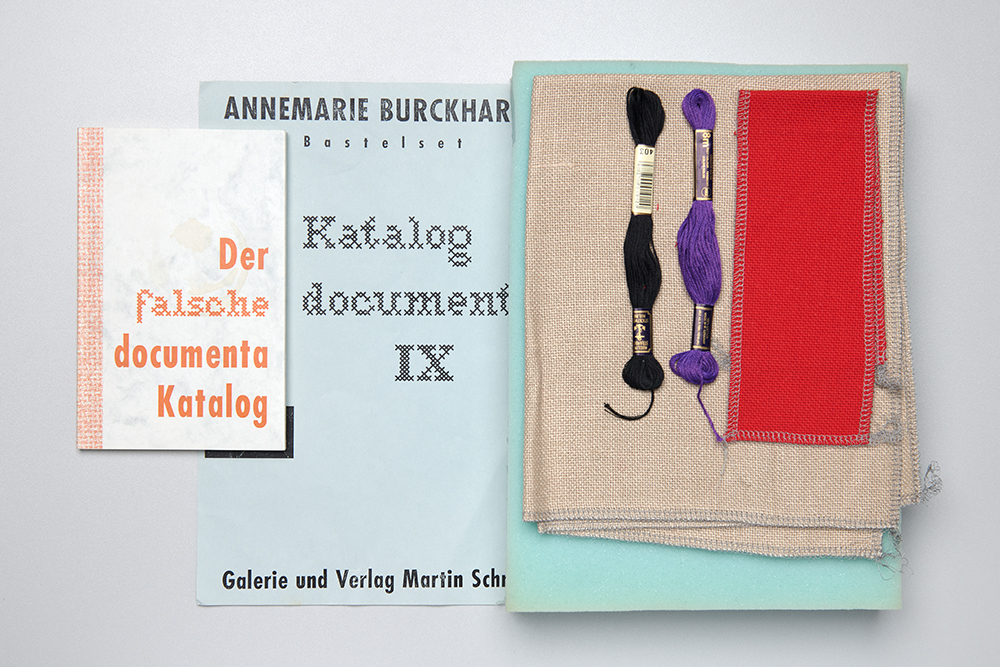
What’s that for? A “fake” documenta catalogue
Dorothee Wierling | 29. December 2021
In the run-up to documenta IX (d9), a “fake” exhibition catalogue made of soft material caused a stir. Dorothee Wierling, co-curator of the exhibition “documenta. Politics and Art” takes a closer look at what all the fuss was about.
On the first floor of our exhibition, the section on “Funding” contains a strange object that looks for all intents and purposes like a book. Wrapped in a coarse cotton cloth that older visitors may still remember from needlework class, its title, neatly cross-stitched, reads: “The Fake Documenta Catalogue”. The accompanying “pattern book” reveals that the so-called “catalogue” in fact consists of a block of foam and nothing else. The satirical work of art, released in an edition of twenty, was the product of textile artist Annemarie Burckhardt , who made this presumptive “catalogue” in 1990, when preparations for the d9 (which actually took place in 1992) were only just ramping up. The work would have garnered little attention if it weren’t for the reaction of the documenta organizers. They claimed the article infringed copyright law and threatened legal action, thus raising the stakes and bringing the artist and her Kassel-based publisher (Martin Schmitz) greater publicity. It was only then that that “copies” started flying off the shelf, albeit not as the limited-edition textile piece but in the form of the accompanying “pattern book” mentioned above. The legal dispute gave the product cult status and even Deutsche Bahn later featured it on one of its regional adverts for the Kassel event. Taken aback by the documenta’s reaction, the artist made a show of naivety, claiming her only wish had been to create a, in her words, “poetic work of art on the theme of ‘the book’”, and making light of her own work as harmless fun.
The media were quick to pounce on the dispute, and some journalists jested that the “fake” catalogue had numerous advantages over the yet-to-be-published genuine article. Unlike that predictably heavy tome, Burckhardt’s work was light, foldable, and could be used as a cushion and, if tossed casually yet prominently onto the rear dash of one’s vehicle, served the exact same function as the paper catalogue – namely to proclaim to all and sundry the owner’s connoisseurship of the latest in art. The then managing director of documenta, Alexander Fahrenholtz, defended the decision to take legal action by saying that it was a matter of preventing the name “documenta” from appearing on items that had nothing to do with the curated event, thereby profiting from its name when, in fact, the documenta itself had every right to “do business” with its name. The move marked an error of judgement on Fahrenholtz’s part. Not only did he misjudge the legal situation – the name was not trademarked, and only the logo of each new edition of the documenta was ever submitted to the patent office for protection – but, worse still, he misgauged the mood of the public. For them, the law suit represented the hubris of the art establishment, specifically the makers of documenta. Moreover, it was read as a sign of dry, even cut-throat earnestness that ran contrary to the progressive image the event itself liked to cultivate. The organizers finally caved in – but the episode continues to be associated with their names and the d9.

In our exhibition, however, we chose to put the object on view not only because it represents a successful piece of artistic provocation, but because it is also indicative of a wider theme. At the time of the legal dispute, the d9 was all set to break previous records, riding a wave that had started in the 1970s and had only gathered momentum with each new iteration of the exhibition. Although the documenta’s portion of state-backed funding had seen incremental increases over time, its self-generated revenues had risen exponentially, mostly thanks to the sale of admission tickets (each new event commanded higher ticket sales, often with a hike in price). Other notable proceeds came from the ever-more costly, elaborately designed catalogues, which often ran to several volumes and could certainly not be classified as a “light” read in any true sense of the word, but which nevertheless went like hot cakes. Added to this mix were donations from private individuals. It should be noted, however, that these represented only a fraction of the additional income that the documenta made public and were overshadowed by the portion of revenue from official sponsors. Major sponsors started co-financing the documenta in the 1970s: first Sony, later also VW, Reemtsma, and Deutsche Bahn, among others. They all negotiated the sums and conditions in secret sponsorship deals that remain strictly confidential even to this day. As the documenta emerged as a revenue-making venture of its own, it led to a shift in the way it perceived itself, away from a government-backed initiative to that of a company that owned a special brand, which, by logical extension, needed protection. But such a trademark is not only of interest to the company behind it in how it views competitors; it is also of interest to consumers, with its value primarily stemming from the cachet associated with it. But those consumers, especially the visitors to the documenta, were not merely interested in the art on show, but also in showing off their own cultural status as educated, open-minded, unconventional citizens and thus a modern type of bourgeoisie. However, such ideals and self-worth did not sit easily with the humourless business-mindedness displayed by the documenta 9 directorial team towards an ironic work of art made of foam, fabric, and needlework. Jan Hoet, artistic director of d9, liked to show himself at the exhibition in a self-confident and self-ironic light, particularly regarding his playful relationship with his main sponsor, the tobacco giant Reemtsma. His playful posturing tickled the public who quietly took note and smiled.